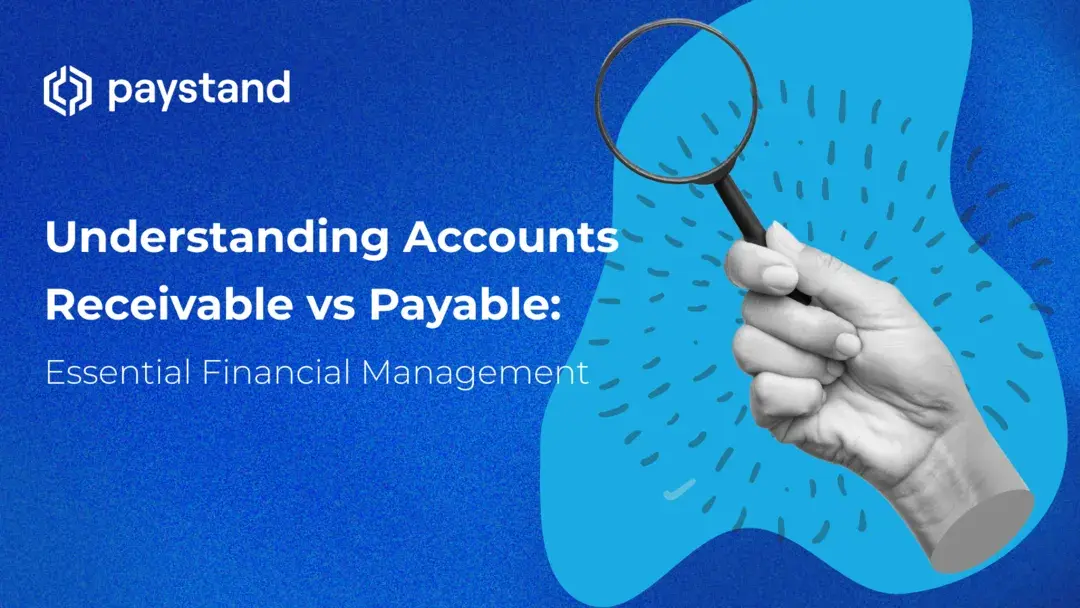Understanding Accounts Receivable vs Payable for Financial Management

Table of Contents
- What is the Difference Between Accounts Payable and Receivable?
- What is the AP and AR Process?
- Do I Send an Invoice to Accounts Payable or Receivable?
- What is the Difference Between AP and AR Invoices?
- Accounts Payable and Receivable Examples
- How Paystand Can Help Manage AR
Key Takeaways
- Effective management of accounts receivable (AR) and accounts payable (AP) is crucial for maintaining a business's positive cash flow and financial health.
- Detailed record-keeping and regular monitoring are essential for accuracy and efficiency in AR and AP processes.
- Paystand offers solutions to streamline AR management through automation, leveraging blockchain and cloud-based platforms to improve efficiency and accuracy.
Accounts receivable (AR) and accounts payable (AP) are essential to a business's financial health. Proper management of AR and AP ensures that a company can maintain a positive cash flow, make timely payments to suppliers, and collect payments from customers efficiently. This balanced management is critical for sustaining operations, funding growth, and avoiding financial pitfalls.
- AR management ensures timely invoicing, overdue payment follow-ups, and accurate records for business cash flow. It maintains liquidity for daily operations.
- AP management involves timely invoice payments, negotiating favorable payment terms, and maintaining good supplier relationships. This avoids late fees, secures early payment discounts, and ensures a smooth supply of operational goods and services.
AR and AP processes involve detailed record-keeping and regular monitoring to ensure accuracy and efficiency. This article covers common AR and AP questions, their differences, examples of their roles, and strategies for effective accounts receivable management.
What is the Difference Between Accounts Payable and Receivables?
- Accounts Receivable refers to the money owed to a company by its customers for goods or services delivered but not yet paid for. It's an asset on the balance sheet, representing future income. AR management ensures that businesses collect payments efficiently and maintain cash flow.
- Accounts Payable represents the money a company owes to its suppliers or vendors for goods or services received but not yet paid for. It is a liability on the balance sheet, representing future cash outflows.
💡Key Differences
- Nature. AR is an asset; AP is a liability.
- Function. AR involves money to be received; AP requires money to be paid.
- Impact on Cash Flow. AR improves cash flow when collected; AP impacts cash flow when payments are made.
Do I Send an Invoice to Accounts Payable or Receivable?
When you send an invoice, it's essential to know whether to address it to accounts payable or accounts receivable. Here's a breakdown of each term and when to use them:
- If you issue an invoice, it should be sent from your accounts receivable to the recipient company's accounts payable department. They will process the payment for the goods or services you provided.
- If you receive an invoice, it should be directed to your accounts payable department for payment processing.
💡Key Differences
- Accounts receivable handles invoices for amounts owed to you.
- Accounts payable handles invoices for amounts you owe.
What is the AP and AR Process?
The AP and AR processes are essential to any business's financial management system. Both processes involve recording, tracking, and managing money owed to and by a company.
Accounts Payable Process
The AP process begins when a company receives goods or services from a supplier. The supplier then sends an invoice to the company, which is recorded in the AP system. The AP department is responsible for verifying the invoice ensuring that the goods or services and the correct invoice amount were received. Once the invoice has been verified, the AP department issues payment to the supplier.
This process allows businesses to track their spending and ensure suppliers are paid on time. It also helps to identify potential fraud or errors in invoices.
Accounts Receivable Process
The AR process begins when a company sells goods or services to customers. The company then issues an invoice to the customer, which is recorded in the AR system. The AR department is responsible for tracking the invoice and ensuring that the customer pays the invoice on time.
This process is essential because it allows businesses to track their sales and ensure that they are collecting payments from their customers. It also helps businesses to identify potential fraud or errors in invoices.
💡Key Differences
| Accounts Receivable Process | Accounts Payable Process |
|---|---|
|
|
What is the Difference Between AP and AR Invoices?
While both serve as billing documents, they represent distinct aspects of a company's financial operations. Understanding the differences between AP and AR invoices is essential for efficient record-keeping, cash flow management, and maintaining accurate accounts.
- AP Invoices. These are invoices that your company receives from suppliers or vendors. They signify an amount your company needs to pay.
- AR Invoices. These are invoices that your company sends to customers. They signify an amount your company expects to receive.
Accounts Payable and Receivable Examples
Accounts Payable Examples
There are a variety of transactions that can lead to accounts payable. Some common examples include:
- Purchasing inventory from a supplier
- Hiring a contractor to provide services
- Receiving a bill for utilities or rent
- Paying interest on a loan
Accounts payable typically have a due date specified on the invoice. Paying accounts payable on time is essential to avoid late fees and damage to the company's credit rating.
For example, a company purchases $10,000 worth of inventory from a supplier on credit. The company records the purchase as a debit to inventory and a credit to accounts payable.
Accounts Receivable Examples
There are also a variety of transactions that can lead to accounts receivable. Some common examples include:
- Selling products or services to a customer
- Providing a loan to a customer
- Renting property to a tenant
Accounts receivable typically have a payment term specified on the invoice. It is vital to collect accounts receivable promptly to avoid bad debt and damage to the company's cash flow.
For example, a company sells $15,000 to customers on credit. The company records the sale as a debit to accounts receivable and a credit to sales revenue.
How Paystand Can Help Manage AR
Paystand offers innovative solutions to streamline and optimize your accounts receivable management, ensuring a healthy cash flow and minimizing the risk of bad debt.
By leveraging blockchain technology and cloud-based platforms, Paystand automates invoicing and collections, reducing time and effort and allowing businesses to send invoices, track payments, and reconcile accounts seamlessly, improving efficiency and accuracy.
Implementing Paystand's solutions can transform your AR processes, making them more efficient and effective. Businesses can focus on growth and customer satisfaction by reducing manual tasks and improving payment collection.
Learn more about the future of finance and how Paystand can help your business stay ahead. This resource offers in-depth insights and strategies for optimizing your financial processes and achieving long-term success.






